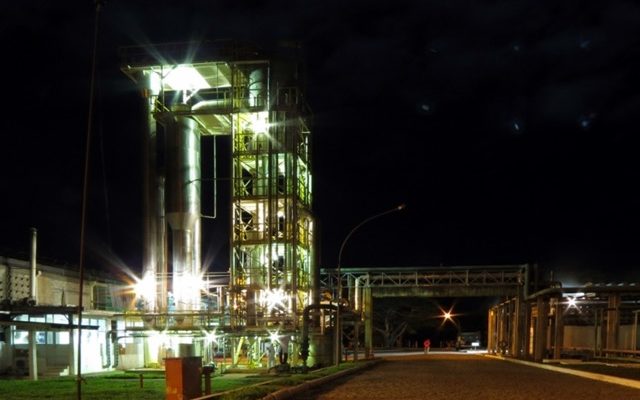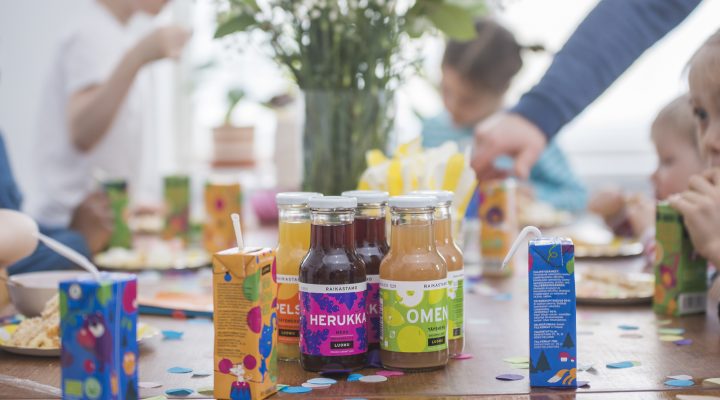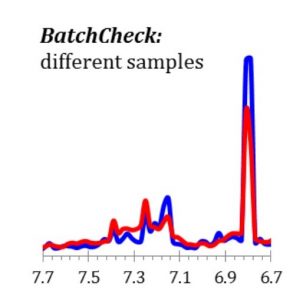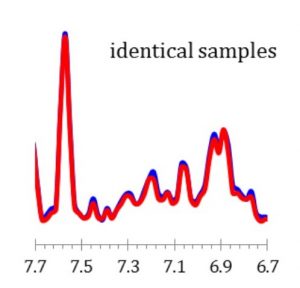Gerald McDonald & Company have been supplying the food and drink industry for 100 years. Since 1917 their mission has remained the same – to source the finest quality ingredients for their customers. Demand from the fruit juice industry for more exotic and unusual ingredients has been on the increase in recent years as consumers tastes become more adventurous, and Gerald McDonald are rising to meet the challenge. Fruit Juice Focus talks with Maxim McDonald a director of the company to find out more about this fascinating side of our industry.
Fruit Juice Focus (FJF): Gerald McDonald has been in the ingredients market for over 100 years now. Can you tell us a bit about the background to the company and how the company has developed over the years?

Maxim McDonald
Maxim McDonald (MM): The company was started in the City of London in the UK over 100 years ago by my great grandfather Gerald J. W. McDonald trading as a spice merchant dealing in herbs and spices. Back then spices were considered an exotic product and the company became well known for being a specialist in this area. Over time they decided to expand into juices, and my grandfather Gerald I. M. McDonald started this side of the business in earnest back in the 1950s when he joined the Citrus Fruit Juice Control Committee. This government backed organisation was set up to help promote fruit juices as a good source of vitamin C in a time of austerity when the government was looking at different ways of getting people to consume vitamin C. From then-on the fruit juice side of the business grew and grew with Gerald McDonald building a name for itself in both the ingredients and the fruit juice market and eventually buying into a citrus processing company in Italy known today as Agres.

We stayed in the City of London up until the year 2000 when we moved out to Basildon, a town 30 miles east of London, in the county of Essex. The decision to move came about primarily due to the need for more space and to consolidate all our activities such as blending, warehousing and administration more efficiently under one roof. We couldn’t just stay as a trading company any longer, time had moved on and customers wanted more from their supplier.
FJF: Can you tell us how the ingredients market has developed in recent years?
MM: The ingredients market is a lot more interesting and varied than it used to be and there are a lot more products that are available now. In the earlier days it was really just the citrus products – your standard orange juice and lemon – and maybe some of the soft fruits but now there is a whole plethora of choices, I think that is happening with everything. there’s a lot of niche markets opening up, not just for general ingredients but for fruit juices as well.
FJF: Can you tell us about some of the more unusual ingredients you are currently working with?
MM: There is one we are working on at the moment which is a washed seaweed purée. We have been developing this with Agres.
This seaweed that has been specifically farmed and cultivated with the purpose of creating a seaweed purée that can be used in juices and a wide range of other food products. Unwashed it has a fishy smell and taste to it which some people either love or hate, but we have eliminated this through the washing process to produce an ingredient that has a neutral colour and flavour. The benefits of using this in juices and other food products is that it is a rich source of minerals and trace minerals, vitamins, antioxidants, amino acids and fibre and is a particularly good source of dietary iodine – all of which will appeal to the health-conscious consumer purchasing juices with this as an ingredient.
We have been working to wash, process and pack it in asceptic bags and we have introduced lemon to acidify the purée as it has a high ph content. We are pleased with the results and have now launched the product into the market. Feedback from customers has been promising since the sample packs were sent out.
Other more unusual ingredients that we deal with include:
Aloe Vera juice which boosts the immune system – high in vitamins, minerals, amino and fatty acids. Our product has a low aloin content so it does not have the bitterness normally associated with some Aloe Vera products.
Prickly Pear, a fruit from the cactus Opuntia cactus plant – our company in Agres is the biggest processor of Prickly Pear in Europe, which is done to a very high quality in 54 Brix Clarified, 38 Brix Puree, NFC and organic formats. This has been growing in popularity with the rise of cactus water products available in the market. It’s also very eco-friendly as it does not need a lot of water to grow.
FJF: How do you go about sourcing ingredients
MM: Because we have been around for a long time we know quite a few of the suppliers in the market just from our history but we also travel around the world to visit existing and new suppliers to see what they are offering, to do audits and to check they have all the correct accreditations – that’s something that is becoming more important now as well. We also attend food shows such as the Anuga food fair and the SIAL food innovation exhibition to meet suppliers.
Some of the ingredients trends go in cycles because the prices can vary from year to year for some of the fruits we use. It will depend on what the farmers can get for the fruit. For example, if they feel like it’s not in their interest to produce a crop due to poor price returns then they quite often just stop growing the fruit and move onto something else.
FJF: Can you tell us a bit more about the research and development side of your ingredients business?
MM: We have a team of dedicated people working in our research and development (R&D) who also work in our laboratory checking and monitoring samples. We are finding that the R&D part of the business is becoming increasingly important for our customers. Until recently they undertook their own R&D and just asked us to supply the ingredients to match what they were looking for, but now we are finding more and more customers are coming to us asking for our opinions, advice and suggestions which has added a whole new side to our operation.
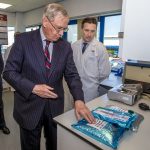
HRH Duke of Gloucester and right, Matthew Cousins technical manager
We deal with customers both large and small and, as you would expect, most of our larger customers will have their own R&D facilities. However, for the smaller companies, those for example who might be just starting up in the fruit juice business our R&D facilities provide an important service. A company may come to us with an idea for a drink made up of some unusual exotic ingredients but will not be sure whether the ingredients or blends will work from a production point of view let alone the taste angle.
We sit down with them and explore all the options from the costs of sourcing the ingredients through to the practicalities of the blending and production process giving as much advice and direction as we can in the early stages. For example, they might have what they think is a brilliant and novel idea for their juice which includes an ingredient that is quite difficult to source at certain times of the year. Picking the wrong ingredient could be a costly mistake. It might be ok if the company is still small in five years’ time but if suddenly sales explode and their chosen ingredients are hard to get then they are going to have major supply and production issues leading to delayed or cancelled orders from their customer base leading to people being let down. Therefore early discussions on appropriate ingredients has to be taken into consideration.
FJF: Do you work with clients from around the world or just in Europe?
MM: We import the ingredients from around the world and store them in our specialist warehousing facilities prior to processing and supplying them to our customers. But our customer base is mainly the UK along with exports to Europe and to a growing market in Asia.
Coming back to the Asian market. Last year we opened an office in Japan – Gerald McDonald Asia – which hasn’t been officially announced yet so this is an exclusive for Fruit Juice Focus! The plan is to replicate in Japan what we are doing here in the UK. And we are going to be exporting a few juices to customers in Japan and also importing juices from Japan back into Europe.
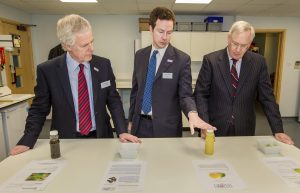
Gerald-McDonald, Maxim McDonald and HRH Duke of Gloucester looking at Yuzu juice
One particular juice we are looking at is yuzu which is a citrus based juice with a taste that is a mix of lemon, mandarin and grapefruit. An interesting taste with a lot of health benefits. Yuzu juice is reported to have three times the amount of vitamin C than normal lemon has and it is beginning to be used in quite a few restaurants in the UK. Waitrose, the UK supermarket chain, has a berry blend that has a bit of yuzu in it and there are some tonics with yuzu in them also. We are now starting to import yuzu from Japan with a view to taking advantage of the predicted demand.
Interestingly the yuzu tree can take many years to grow to full fruit bearing maturity leading to yuzu becoming a very precious fruit. In Japan people not only love yuzu juice, they also use its peels in tea or for seasoning purposes in foods and they even float them in the bath for skin care! The yuzu tree can live for 100 to 300 years or more.
FJF: With your own blending facilities and a research and development lab as well as a packaging facility are you self-sufficient in the whole process of sourcing through to delivery?
MM: Yes, I think that’s definitely one of the value-added services that we offer. As well as blending we then have the ambient, chilled and frozen storage option so everything is stored under BRC conditions and if customers want frozen juice instead of asceptic juice for instance then we can supply that.
We employ more than 50 staff in the UK now and we looking to expand the blending facility as we still have space on this site. For the moment that is! The Basildon location has good links with ports and motorways with the London Gateway and Tilbury port close by and many large companies are settling here including Costa the leading coffee retail chain who have their main UK roastery here.
FJF: Can you tell us about some of the challenges you as a business face going forward and the industry as a whole?
MM: Timing is always a challenge in the fruit juice business because unfortunately nature doesn’t always do what you want it to! Sometimes crop seasons can be late. For instance, this year we were supposed to be getting offered lemon prices from producers in Argentina in March but they are only just starting to come through now. A lot of customers were expecting lemon to be ready much earlier but it has been considerably delayed. This has been due primarily to the weather in the north of Argentina where a lot of the lemon crop is grown. There has been extensive, unseasonal rain and a lot of flooding so it hasn’t been physically possible for anyone to pick the lemons off the trees. You have customers wondering what’s happening and what’s going on and you are trying to hurry things along to get the fruit and the prices in but it’s so unpredictable at times like this.
There is obviously the whole sugar tax issue which affects our customers more than us but in a way we haven’t really seen the full effect of it yet. Because we deal a lot with citrus products like lemon which is not associated with being bad for you it hasn’t really been a problem for us so far. The soft drink companies have really acted quickly to change their recipes before it is actually implemented which is a good thing as we thought they would take much longer to react.
As a business we have high hopes for the Japanese market and are closely watching to see how it goes. It is a very difficult market and we plan to be there for the long term as it will take a while before things really take off there. As mentioned earlier we now have an office in Kobe staffed by Japanese colleagues and we are off to Japan next month to display the company’s products at several exhibitions including the Tokyo Café Show where we are promoting some British drinks there and some of the ingredients that we can offer.
Even though Japanese tastes are very different – they are very big on seaweed for instance whereas in the UK it is just starting to develop – the market is a very mature one like the UK. You get a lot of different products and there are some quite adventurous tastes in Japan just as there are in the UK. We think there are some key similarities despite the different cultures and there are some things that connect the two and we hope to take advantage of that. The Japanese love British food and drink as well so we feel that our investment in Asia will be a positive one for the future of Gerald McDonald.



